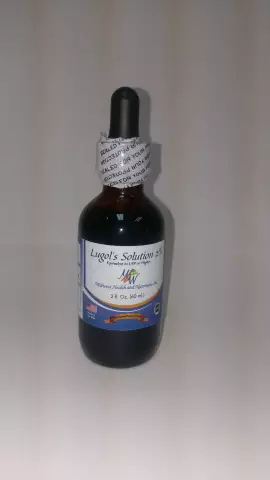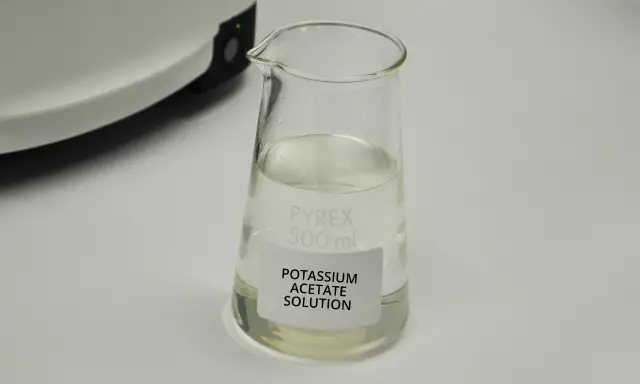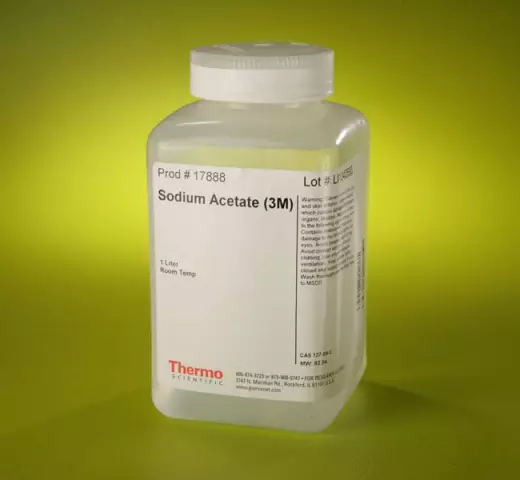- Author Rachel Wainwright [email protected].
- Public 2023-12-15 07:39.
- Last modified 2025-11-02 20:14.
Strofantin K
Latin name: Strophanthin K
ATX code: C01AC
Active ingredient: strophanthin-K (Strophanthin-K)
Manufacturer: JSC "Galichpharm" (Ukraine)
Description and photo update: 2020-15-01

Strofantin K is a herbal medicine for the treatment of heart failure of various etiologies, which has a cardiotonic and antiarrhythmic effect.
Release form and composition
Dosage form - solution for intravenous (i / v) and intramuscular (i / m) administration: clear liquid from colorless to slightly yellowish (1 ml each in ampoules made of colorless transparent glass, in a cardboard box with a corrugated liner, 10 ampoules with an ampoule scarifier; 1 ml in ampoules made of colorless transparent glass, in a blister strip of 10 ampoules, in a cardboard box 1 pack of ampoules and an ampoule scarifier. Scarifier is not provided if ampoules with a dot / ring of break are used. Each pack also contains instructions for use of Strofantin K).
Composition for 1 ml of solution:
- active substance: strophanthin K - 0.25 mg;
- auxiliary components: ethyl alcohol 96% - 0.02 ml; water for injection - up to 1 ml.
Pharmacological properties
Pharmacodynamics
Strophanthus K is a mixture of cardiac glycosides extracted from the seeds of the tropical liana Strophanthus Kombe Oliver, such as K-strophanthoside, K-strophanthin-β, etc. It belongs to the group of polar (hydrophilic) cardiac glycosides, slightly soluble in lipids and poorly absorbed from the digestive tract.
The seeds of Strophanth Combe contain strophantidine derivatives - glycosides of cardiotonic action (such as cardenolides). The main ones are: K-strophanthoside ~ 2%, K-strophanthin-β ~ 0.6%, cymarine ~ 0.3%, cymarol ~ 0.28%. In addition, the seeds contain helveticoside, glucogelveticozoid, glycocymarol, emicmarin, periplocymarin, and fatty oil.
Strofantin K is a short-acting cardiac glycoside. It blocks the transport of sodium-potassium adenosine triphosphatase (Na + / K + -ATP-ase), as a result of which the content of sodium ions in cardiomyocytes increases, promoting the opening of calcium channels and the entry of calcium ions into cardiomyocytes. An excess of sodium ions accelerates the release of calcium ions from the sarcoplasmic reticulum, which increases the intracellular level of the latter, blocking the troponin complex, which inhibits the mutual action of actin and myosin.
Strofantin K potentiates the strength and rate of contraction of the heart muscle in a different way from the Frank-Starling mechanism, independent of the degree of myocardial pre-stretching. The systole is shortened and becomes energetically economical, the stroke and minute blood volume increase due to an increase in myocardial contractility. The end-systolic and end-diastolic volumes decrease, increasing the tone of the heart muscle, which leads to a reduction in its size and, consequently, to a decrease in the heart's oxygen demand.
The negative dromotropic effect is expressed in the development of refractoriness of the atrioventricular (AV) node, thereby allowing the use of this cardiac glycoside in supraventricular paroxysmal tachycardia and tachyarrhythmias. In patients with atrial fibrillation, the drug slows down the heart rate (heart rate), lengthens diastole, improving systemic and intracardiac hemodynamics. A decrease in heart rate occurs as a result of a direct and indirect effect on the regulation of the heart rate. Strofantin K is a direct vasoconstrictor for patients with normal contractility or with excessive myocardial stretching, if the positive inotropic effect of cardiac glycosides is not manifested. In patients with CHF (chronic heart failure), the vasodilating effect of the drug is realized indirectly,by lowering venous pressure and increasing urine output, which reduces swelling and dyspnea. Reception of strophanthin-K in toxic and subtoxic doses provides its positive batmotropic effect. The negative chronotropic effect is manifested to an insignificant extent.
When administered intravenously, the action of Strofantin K begins after 10 minutes and reaches its maximum effect after 15-30 minutes.
Pharmacokinetics
There is practically no cumulative effect of strophanthin K.
The substance is distributed in tissues and organs relatively evenly; a slightly higher degree of concentration is noted in the pancreas, adrenal parenchyma, liver, kidneys; ~ 1% of the administered dose is found in the heart muscle.
Strophanthin K binds to plasma proteins at a level of 5%.
The substance is not subject to metabolism, it is excreted unchanged by the kidneys. From 85 to 90% of the drug is excreted within 1 day. Plasma concentration in the blood decreases after 8 hours by 50%, complete elimination from the body occurs after 1-3 days.
Indications for use
The indications for Strofantin K are:
- chronic and acute heart failure of the II functional class according to the classification of the New York Heart Association (NYHA), in the presence of clinical manifestations, and III - IV functional class - as part of complex therapy;
- paroxysmal and chronic course of atrial fibrillation and atrial flutter in a tachysystolic form, especially when combined with CHF.
Contraindications
Absolute:
- WPW syndrome (Wolff - Parkinson - White syndrome);
- glycosidic intoxication;
- 2nd degree AV block;
- intermittent AV block or complete sinoatrial block;
- pregnancy and the period of breastfeeding;
- hypersensitivity to the components of Strofantin K.
With caution, the glycoside should be used for cardiac pathologies: 1st degree AV block, SSS (sick sinus syndrome) without an artificial pacemaker, the likelihood of unstable conduction along the AV node, a history of Morgagni-Adams-Stokes syndrome, hypertrophic obstructive cardiomyopathy, isolated mitral stenosis with a decrease in heart rate, cardiac asthma in patients with mitral stenosis (if there is no tachysystolic form of atrial fibrillation), acute myocardial infarction, unstable angina pectoris, arteriovenous bypass grafting, hypoxia, constrictive amycarditis, heart failure with restrictive diastolic heart disease, constrictive pericarditis, cardiac tamponade), ventricular premature beats, severe dilatation of cardiac cavities, cor pulmonale,atrial extrasystole (its transition to atrial fibrillation is possible); in patients with the following electrolyte disturbances: hypomagnesemia, hypokalemia, hypercalcemia, hypernatremia; with hypothyroidism, alkalosis, myocarditis, failure of renal and / or hepatic function, thyrotoxicosis, as well as in old age.
Strofantin K, instructions for use: method and dosage
Strofantin K solution is intended for intravenous or intramuscular administration. The drug is used exclusively in emergency situations when the use of cardiac glycosides inside is impossible.
Methods for intravenous administration of the drug:
- injection (Strofantin K is preliminarily diluted with 10-20 ml of 0.9% NaCl solution or 5% dextrose / glucose solution): injected intravenously slowly over 5-6 minutes, since a faster introduction can cause shock;
- infusion (preliminarily Strofantin K is diluted in 100 ml of 0.9% NaCl solution or 5% dextrose / glucose solution.): injected intravenously, with this form of administration, the toxic effect develops less often.
For adult patients, the maximum doses of strophanthin K for intravenous administration are: single - 2 ampoules (2 ml), daily - 4 ampoules (4 ml).
If, for a number of reasons, the solution cannot be injected into a vein, it is recommended to inject it into the muscle. To do this, in order to reduce sharp pain with i / m administration, 5 ml of a 2% solution of procaine (novocaine) is injected, followed by the required dose of Strofantin K solution, previously diluted in 1 ml of a 2% solution of procaine (novocaine), through the same needle … Doses for i / m injections are 1.5 times higher than doses for i / v.
Daily doses (saturation doses when using 0.025% Strofantin K solution) for pediatric patients, depending on age:
- newborns (up to 30 days): 0.06-0.07 ml / kg;
- infants and children from 1 month to 3 years: 0.04-0.05 ml / kg;
- children from 4 to 6 years old: 0.4-0.5 ml;
- children and adolescents from 7 to 14 years old: 0.5-1 ml.
The maintenance dose for children strophanthin K is 1 / 2 - 1 / 3 of the loading dose.
Side effects
- CVS (cardiovascular system): bradycardia, AV block, extrasystole, ventricular fibrillation, ventricular paroxysmal tachycardia;
- Gastrointestinal tract (gastrointestinal tract): decreased appetite, diarrhea, nausea, vomiting;
- CNS (central nervous system): dizziness, headache, fatigue, sleep disturbances, changes in color perception, drowsiness, psychosis, depression, confusion;
- other reactions: hypersensitivity, urticaria, gynecomastia, thrombocytopenia, thrombocytopenic purpura, petechiae, nosebleeds; with i / m injection - soreness at the injection site.
Overdose
Symptoms of a Strophanthin K overdose:
- from the CVS: arrhythmias, including bradycardia, AV block, ventricular paroxysmal tachycardia, ventricular fibrillation, ventricular extrasystole (bigeminia, polytopic extrasystole), nodal tachycardia, sinoatrial block, atrial fibrillation and flutter;
- from the digestive tract: nausea, vomiting, anorexia, diarrhea;
- from the side of the central nervous system and sensory organs: increased fatigue, headache, dizziness; rarely - decreased visual acuity, staining of surrounding objects in green and yellow colors, scotoma, flashing of flies in front of the eyes, macro- and micropsia; extremely rarely - syncope, confusion.
If any signs of intoxication appear, Strofantin K cancel or reduce subsequent doses and increase the time intervals between injections of the solution.
If necessary, it is recommended to administer antidotes, for example, Unithiol (sodium dimercaptopropanesulfonate) and symptomatic treatment (antiarrhythmics, potassium preparations, m-anticholinergics).
Therapy of pathologies caused by cardiac glycoside poisoning:
- cardiac arrhythmias: the use of class I antiarrhythmics (for example, lidocaine, phenytoin);
- hypokalemia: intravenous drip for 3 hours the introduction of a solution of potassium chloride - 6-8 g / day (at the rate of 1-1.5 g of potassium chloride per 0.5 L of 5% dextrose / glucose solution) and insulin - 6 -8 UNITS;
- severe bradycardia, AV block: m-anticholinergics (for example, atropine sulfate). Introducing beta-adrenergic agonists is dangerous, since they can enhance the arrhythmogenic effect of cardiac glycosides;
- complete transverse blockade with Morgagni-Adams-Stokes syndrome: temporary pacemaker (electrocardiostimulation).
special instructions
With extreme caution, Strofantin K is used according to indications for thyrotoxicosis and atrial extrasystole.
Since the therapeutic index of a substance is very low, during its use it is important to ensure an individual dose selection and careful medical monitoring of the patient during treatment.
In order to prevent glycoside intoxication in patients with impaired renal excretory function, the dose of strophanthin K is adjusted downward.
The likelihood of overdose increases in patients with hypokalemia, hypercalcemia, hypernatremia, hypomagnesemia, cor pulmonale, pronounced dilatation of the heart chambers, alkalosis and in old age. In case of violations of AV conduction, special care is required and electrocardiographic monitoring of the patient's condition is required.
Severe mitral stenosis, normo- or bradycardia contribute to the development of CHF due to a decrease in diastolic filling of the left ventricle. Strofantin K increases the contractility of the right ventricle, causing a further increase in pressure in the pulmonary artery system, which may result in pulmonary edema or worsening of left ventricular failure. Patients with mitral stenosis are prescribed cardiac glycosides provided that right ventricular failure or atrial fibrillation is present. In patients with Wolff-Parkinson-White syndrome, by reducing AV conduction, Strofantin K promotes the conduction of impulses along accessory pathways bypassing the AV node, thereby provoking attacks of paroxysmal tachycardia. One of the methods to control digitalization is to monitor the plasma content of cardiac glycosides.
Rapid intravenous administration of the solution can provoke ventricular tachycardia, bradyarrhythmia, AV block and cardiac arrest. At the peak of the action of Strofantin K, the development of extrasystole is possible, sometimes in the form of bigeminy. In order to prevent this reaction, the dose is recommended to be divided into 2-3 intravenous administrations or the first dose is administered intramuscularly.
If the patient has previously been prescribed other cardiac glycosides, a break of 5 to 24 days is required before the intravenous administration of Strofantin K, depending on the severity of the cumulative characteristics of the previous agent.
Influence on the ability to drive vehicles and complex mechanisms
During the period of application of Strofantin K, it is necessary to refrain from engaging in potentially hazardous activities that require increased concentration of attention and speed of psychomotor reactions, including from driving vehicles.
Application during pregnancy and lactation
Strofantin K is contraindicated for use during pregnancy and breastfeeding due to the lack of data on the effectiveness and safety of its use in these groups of patients.
Pediatric use
In pediatric practice, the drug is used according to indications, in a dose that depends on the age and body weight of the child.
With impaired renal function
For the treatment of patients with renal insufficiency, Strofantin K should be used with caution.
For violations of liver function
For the treatment of patients with hepatic impairment, Strofantin K should be used with caution.
Use in the elderly
For elderly people, Strofantin K is prescribed with caution.
Drug interactions
- barbiturates (phenobarbital, etc.): reduce the cardiotonic effect of cardiac glycosides;
- sympathomimetics, methylxanthines, reserpine and tricyclic antidepressants: when used with Strofantin K, they increase the risk of arrhythmias;
- quinidine, methyldopa, amiodarone, captopril, calcium antagonists, erythromycin and tetracycline: increase the plasma level of strophanthin K in the blood;
- magnesium sulfate: increases the likelihood of slowing impulse conduction and the occurrence of AV blockade of the heart;
- diuretics (mainly thiazide and carbonic anhydrase inhibitors), GCS (glucocorticosteroids), corticotropin preparations (adrenocorticotropic hormone), insulin, carbenoxolone, calcium preparations, laxatives, benzylpenicillin, amphotericin B, salicylates: increase the likelihood of cardiac glycoside poisoning;
- antiarrhythmics, beta-blockers, verapamil: they can not only increase the severity of the decrease in AV conduction (negative dromotropic effect), but also increase the negative chronotropic activity of Strofantin K (decrease in heart rate);
- rifampicin, phenytoin, phenobarbital, phenylbutazone, other inducers of microsomal hepatic enzymes, as well as cytostatics and neomycin: lower the content of strophanthin K in blood plasma;
- mineralocorticoids, carbonic anhydrase inhibitors: due to the development of hypokalemia, they can cause glycosidic intoxication. When used simultaneously with cardiac glycosides, regular monitoring of the concentration of potassium in the blood plasma is necessary;
- preparations of potassium salts: in combination with cardiac glycosides, it is impossible to use if, under the influence of the latter, conduction disorders develop, confirmed by an ECG (electrocardiogram). Combined with digitalis preparations, potassium salts are often prescribed to prevent cardiac arrhythmias;
- anticholinesterase drugs: used simultaneously with cardiac glycosides increase bradycardia;
- edetic acid: reduces both the effectiveness of cardiac glycosides and their toxicity;
- triphosadenine (sodium adenosine triphosphate): improving metabolism, increases the risk of side effects (including arrhythmogenic effects). Use in conjunction with cardiac glycosides is contraindicated;
- vitamin D hypervitaminosis: enhances the effect of cardiac glycosides due to the development of hypercalcemia;
- paracetamol: may inhibit renal elimination of cardiac glycosides;
- diuretics and corticosteroids: increase the likelihood of developing hypomagnesemia and hypokalemia;
- ATP (angiotensin-converting enzyme) inhibitors, angiotensin II receptor blockers: reduce the likelihood of hypomagnesemia and hypokalemia.
Analogs
Analogs of Strofantin K are Digoxin, Digoxin Grindeks, Korglikard, Korglikon, Lily of the valley tincture, Strofantin-G, Celanid, etc.
Terms and conditions of storage
Store at temperatures up to 25 ° C. Keep out of the reach of children.
The shelf life is 3 years.
Terms of dispensing from pharmacies
Dispensed by prescription.
Reviews about Strofantine K
Today, there are practically no reviews of Strofantin K from patients.
Experts, examining cardiac glycosides, warn of their effect on all basic functions of the heart, and therefore they recommend using the drug with extreme caution. A characteristic feature of glycosides is a specific effect on the myocardium: in small doses, they increase the contraction of the heart muscle, in large doses they inhibit the work of the heart and can cause cardiac arrest.
Price for Strofantin K in pharmacies
The drug is not available for sale, so the price of Strofantin K is unknown.
The cost of the group analogue - Strofantin-G, solution for injection, 0.025%, for a package of 10 ampoules of 1 ml each is about 66 rubles.

Maria Kulkes Medical journalist About the author
Education: First Moscow State Medical University named after I. M. Sechenov, specialty "General Medicine".
Information about the drug is generalized, provided for informational purposes only and does not replace the official instructions. Self-medication is hazardous to health!






